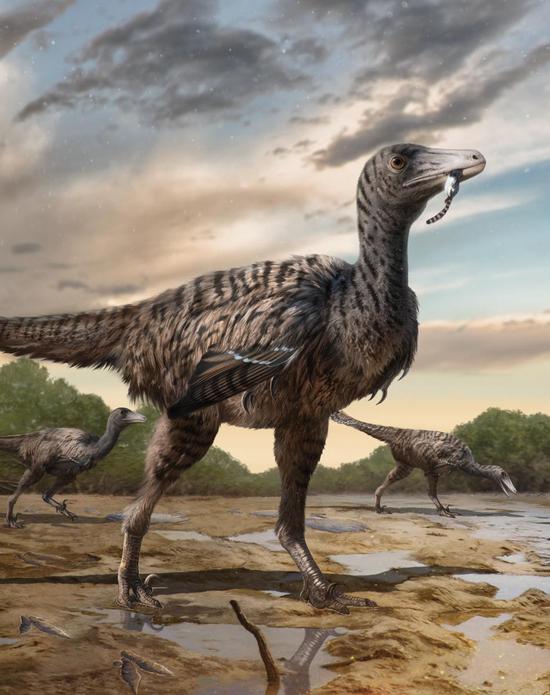
The largest known Deinonychus is depicted in this artist’s recreation. Tracks of an extinct dinosaur species were recently discovered in Fujian Province. (Image courtesy of China Daily)
Chinese and foreign scientists in Fujian province have discovered giant dinosaur tracks, which they say are the largest known deinonychosaur tracks ever found, and lead to the creation of a new type of track species.
A paper on the discovery was published last month in the academic journal iScience.
A large Late Cretaceous (110.5-66 million years ago) dinosaur track site found in Longyan’s Shanggang County, the research team found some of the largest Deinonychus tracks, with the extinct species estimated to have a body length of at least 5 meters. About 2 meters tall at the waist, it is comparable to the South China Tyrannosaurus and Utahraptor, two fearsome dinosaur species previously discovered.
A team of Chinese and foreign scientists led by the China University of Geosciences (Beijing) and the Fujian Yingliang Stone Natural History Museum announced the discovery on Monday.
In 2020, the museum and university launched a joint scientific expedition to search for dinosaur fossils in Fujian. Last year, the expedition team named a large Late Cretaceous dinosaur track site discovered in Shanghai the „Fujian Longxiang Dinosaur Track Group,” and a related paper was published in the academic journal Cretaceous Research.
Xing Lida, an associate professor at the university, said the footprint site has a large area, good preservation and strong diversity. Currently, at least eight dinosaur species have been identified, including the large sauropods, theropods, and others. Among them, there are 12 bipedal theropod dinosaur footprints that are clearly divided into two types of deinonychosaurs based on their size and morphology.
Deinonychosaurs lived from the Jurassic period (199.6-145.5 million years ago) to the Cretaceous period (145-66 million years ago). Their second toe on the hind foot has a large, sickle-shaped claw, and the killing claw is usually raised during movement, leaving two footprints on the ground, made up of the third and fourth toes.
Of the bipedal footprints found, Jing said, the largest bipedal tracks averaged about 36.4 centimeters long and 16.9 centimeters wide — 28.5 centimeters longer than the previously discovered Shandong Deinonychus footprints. The largest Deinonychus footprints ever discovered.
„From a morphological perspective, Longxiang’s large two-toed footprints do not match the characteristics of all previously established Deinonychus footprint types,” he said. Based on research needs, the team established a new footprint taxonomy and named this type of footprint Pujianibus yingliangi, a footprint left by a large megalosaurid dinosaur.
Renowned dinosaur expert Stephen Brussaud from the University of Edinburgh in England said: „By mid-Cretaceous Asia, large allosauroids gradually disappeared, and the iconic dinosaur groups of Tyrannosaurus and large Deinonychus seemed to be competing for the crown of medium-sized predators. Fujianipus yingliangi footprint creator was a brave attempt at this competition.”
Niu Gecheng, Director of Fujian Yingliang Stone Natural History Museum, said the discovery of Fujianibus yingliangi greatly expands the size range of Deinonychus footprints, demonstrating the research potential of the Fujian Longxiang Dinosaur Track Site and its significant importance for the study of the Late Cretaceous. Dinosaur fauna in China.

„Oddany rozwiązywacz problemów. Przyjazny hipsterom praktykant bekonu. Miłośnik kawy. Nieuleczalny introwertyk. Student.


